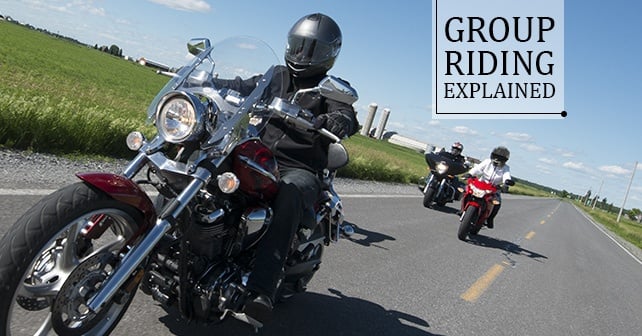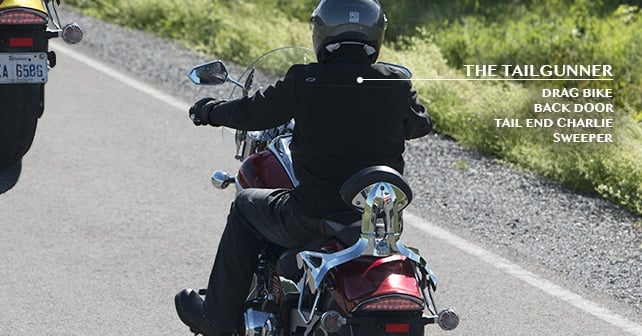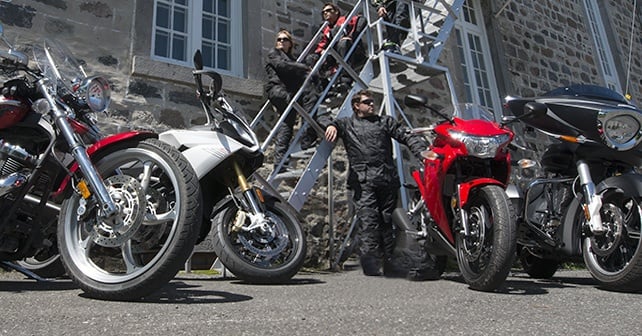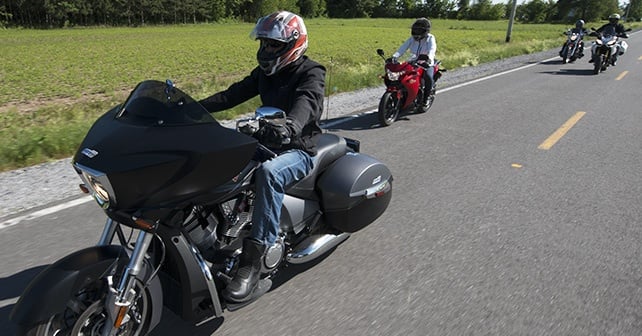GROUP RIDING OR NOT?
There is a debate that rages on among riders all over the world, and It’s not the helmet laws suck debate, or the loud pipes debate, or the should your gear match your bike debate: rather, it’s the debate about whether or not group riding is fun, safe, and even necessary.
Some folks feel that it’s just a grown-up game of “follow the leader”, and naturally none of us like to be seen as just followers. Some feel it’s a dangerous activity, and yet others think it’s the height of camaraderie and fun among riders. I’m not here to debate any of those things, I feel that your mind is your own to make up. However, I doubt very much that you can ride for long in this country without being invited to join a group ride, and you’re going to have to decide whether to dive in or bail out.
MECHANICS OF GROUP RIDING
In some situations however, I feel that disdain for the group ride, or fear of it, might just come from either not knowing how the group ride “really works” or that the stranger beside you might not understand the rules and roles that are part of this popular pastime. So rather than argue with you about the merits, let’s instead discuss the mechanics of the group ride, and especially the people who control it, and see if maybe that helps someone make their mind up about it.
First and foremost, I think it’s important to remember that the group riding situation, whether in a small group or large, is NOT merely “follow the leader”, and it’s not just for rookies. As a matter of fact, I have heard loudly and often (perhaps from my own lips) that riding in large groups is emphatically not for new riders, because riding in close proximity to others takes skill, confidence, and good judgement, all of which develop with experience. What group riding really is, when done well, is an unrehearsed yet well-executed bit of precision riding wherein you count on your riding cohorts as much as yourself- and those cohorts are perhaps the least understood part of group riding, because it is so much more that “just follow that guy”. A well planned and executed ride will actually employ several key riding positions, and those people can make or break the activity by their actions and decisions.
THE RIDE CAPTAIN
There are several key roles in a group ride, but the one we all hear about is “Ride Captain”, so let’s start with that. The Ride Captain is just that- the person in charge of the overall ride. The RC has likely ridden the planned route several times, to establish where the stops will be, where extra caution might be needed, and so that they know the route inside and out, backwards and forwards (sometimes literally!).
The Ride Captain needs to know the rules of the road impeccably, and be a considerate, thoughtful, level-headed EXPERT rider. They will be in charge of nearly every aspect of the ride, from ensuring safety equipment is properly used to deciding what speed the group will travel at. If things go well the RC will be applauded, and if they don’t the RC will be blamed. Usually the RC will lead the pre-ride meeting, control pre-parking, direct traffic controllers who are guiding riders as they arrive, liaise with event Coordinators, and make the decision to get the group on the road. The potential duties are staggering! My favorite Ride Captain of all time is a motorcycle riding instructor LEO. His skills are extreme, his knowledge immense, and his patience (mostly) angelic. You know those Police riding videos where they do all the cones and ridiculous slow riding and tight turns in time trials? He TEACHES that stuff. This is the caliber of rider you should see at the head of the pack- sometimes the RC doubles as the LEAD BIKE as well (more later).
THE TAILGUNNER
Sometimes regarded as the Assistant Ride Captain, the very last rider in the pack should be every bit as experienced and skilled as the one at the front. The Drag will hopefully have communication with the RC or Lead Bike and will advise them of the status of the group ahead, traffic patterns or issues, alert the group to any breakdowns that happen, and a thousand other details. Tailgunners may actually be chosen from the most experienced riders available because they have to choose when to secure the lane as the group leader asks for moves right or left- ie: they move over first and block traveling traffic from behind from getting into the lane, and slam the door on merging traffic that might try to pass as the group moves over. The Drag will probably either stop to help riders who have broken down or stopped for other reasons, and will generally work to keep the pack tight and together, reduce “rubber banding” where the group expands and contracts due to speed and road changes, and may actually advise a rider who is having trouble being in the pack or riding safely to fall back to second-last, or even leave the ride. They are the eyes and ears of the RC at the rear of the pack, and may function as the RC’s voice as well. While the Ride Captain and/or Lead Bike lead the group, the Tailgunner controls it. Pay attention to your Drag Bike rider and do as they ask.
THE LEAD BIKE
Sometimes, especially in larger rides, the Ride Captain has too much on the go to actually perform the mechanics of directing the group through the ride. In that case, the Lead will take over that function. Again, a very experienced, skilled, and safety-oriented rider is required. As the name suggests, the Lead will take the group through the actual riding portion of the day- deciding speed, lane choice, single or double file, advising of any debris or dangers on the road, warning of upcoming turns, and generally keeping the pack moving safely. Most often, they are acting as the brains of the operation, they get to all choices first, and are expected to make the correct, safe, rational choice and then communicate that decision on down the line. I like having a pillion behind me when riding Lead, so I can communicate to her the hand signals that are required to inform the group of what’s going on and keep my hands on the grips the whole time, but it’s not a necessity. The Lead will very likely ride the route along with the RC several times, so that they too know every vagary of the planned trip.
PARKING HANDS
Often left out of these discussions, the people who help arriving riders park in a predetermined fashion so as to facilitate an orderly, safe departure for the group when the ride begins. These beleaguered and picked-on folks do their level best to bring order to chaos, arriving long before the first bikes and usually staying behind to help clean up the starting point. They have to deal with the solo riders that “want to be at the head of the pack for safety” but arrive dead last, the Road Captain, the Coordinator, and everyone in between. They have one significant but sometimes extremely tasking job, and should be considered to be as much in authority as the Ride Captain. That guy or girl in the blaze bright safety vest with the extra extra tall coffee going cold nearby deserves as much respect as anyone else on the ride crew.
CONCLUSION
Those are the bones of the Ride Crew. Every group, every locale, every Ride Captain has their own take on these positions, and it’s good to be familiar with the local traditions before joining the ride. If you’ve decided to participate, learn who these riders are, and pay attention to them, however they will likely all tell you the same thing- RIDE YOUR OWN RIDE. That doesn’t mean ignore what’s going on around you, what it means is that if you feel unsafe, if the ride is progressing beyond your skill set or comfort level, then make the decision to either keep up, or get out. There’s no shame in bailing out of a group ride if the alternative is potentially causing or experiencing an unpleasant end to the ride. Safety First will always be the motto of any decent group ride, and the rest of the group would rather you bow out than endanger them. Learn the hand signals used in your area (they do vary) and pay attention when they’re passed down the line.. but don’t just blindly change lanes because everyone else is- you need to still check for your own safe line of travel and use it, and the same applies for every other stage of the event.
Hopefully, if you decide to try group riding, you have fun. If you don’t, I hope that you won’t try to dissuade others from making up their own minds. It can be a tremendous amount of fun, an enjoyable challenge, and being part of a pack of 500+ motorcycles cruising down the road is a charge unlike anything else. There’s a reason it’s such a popular way to bring attention to things like charities and health causes; people pay attention to the pack.
So at the end of the day, it’s the Ride Crew who make it happen. Cheers to those who lead us out, and back home safely.





